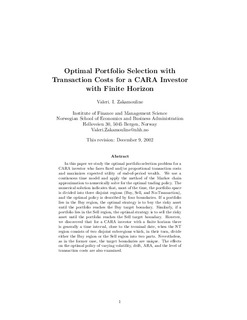Optimal portfolio selection with transaction costs for a CARA investor with finite horizon
Working paper
Permanent lenke
http://hdl.handle.net/11250/164033Utgivelsesdato
2002-12Metadata
Vis full innførselSamlinger
- Discussion papers (FOR) [566]
Sammendrag
In this paper we study the optimal portfolio selection problem for a CARA investor who faces fixed and/or proportional transaction costs and maximizes expected utility of end-of-period wealth. We use a continuous time model and apply the method of the Markov chain approximation to numerically solve for the optimal trading policy. The numerical solution indicates that, most of the time, the portfolio space is divided into three disjoint regions (Buy, Sell, and No-Transaction), and the optimal policy is described by four boundaries. If a portfolio lies in the Buy region, the optimal strategy is to buy the risky asset until the portfolio reaches the Buy target boundary. Similarly, if a portfolio lies in the Sell region, the optimal strategy is to sell the risky asset until the portfolio reaches the Sell target boundary. However, we discovered that for a CARA investor with a finite horizon there is generally a time interval, close to the terminal date, when the NT region consists of two disjoint sub-regions which, in their turn, divide either the Buy region or the Sell region into two parts. Nevertheless, as in the former case, the target boundaries are unique. The effects on the optimal policy of varying volatility, drift, ARA, and the level of transaction costs are also examined.
Utgiver
Norwegian School of Economics and Business Administration. Department of Finance and Management ScienceSerie
Discussion paper2002:20
